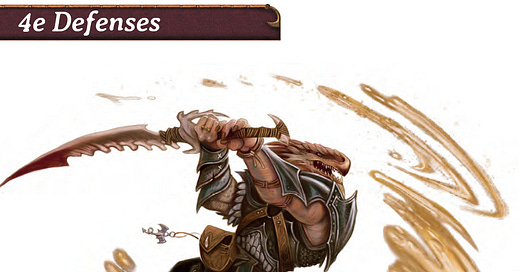D&D 4e: Where Are the Saving Throws?
Navigating the Difference Between 4e Defenses and 5e Saves
With a new edition of D&D on the horizon, I am imagining a world where the next version of Dungeons and Dragons is actually 4th edition. These posts highlight some of the key differences between 5e and 4e.
We’ve all been there. You are in the middle rounds of a combat encounter that has been back and forth from the start. You and your allies have been moving about trying find the most advantageous positions.
You are playing a Dragonborn Barbarian and notice that three enemies are now perfectly aligned to be the recipients of your breath weapon. You get yourself positioned to get the most from the 15-foot cone and let fly a wall of fire.
And this is where things take a turn.
In 5th edition, each of the three targets will need to roll a Dexterity saving throw to see if they avoid taking damage. The DM makes these rolls and lets you know the results. You roll the damage.
In 4th edition, you roll an attack against each target’s Reflex defense. You then roll the damage for the attacks that hit.
These two approaches achieve the same result, but let’s compare the key differences.
Who rolls the dice?
This is the most substantial difference.
In 5e, the target rolls the saving throw to see if they avoid the attack.
In 4e, the attacker rolls to see if they succeed.
Is one approach better than the other? Much of this comes down to personal preference, but let me share why I think the 4e approach is superior.
4th edition keeps the control with the player making the attack. It is the player’s action, the player’s attack, and the player got to roll the dice to determine what happened. With 5e, the player simply said what they were doing and the DM made the rolls. Why do they get all the fun.
I like keeping the control with the player as much as possible. Let THEIR dice decide if they are successful, not the DMs.
Not to mention, the DM has a lot to do as it is. The 4e approach is one less thing the DM has to deal with.
How many defenses to track?
Every Role Playing Game is a balance between giving the players a lot of options and not making things too complicated. 5th edition is known for focusing on simplicity. But this is an area where 4th edition has an edge.
In addition to armor class (AC), 5th edition characters have one saving throw value for each of the six abilities. That is seven defensive values in total.
4th edition reduces this by three. Each character has an armor class plus Fortitude, Reflex, and Will defenses. Four in total.
Is this a big deal? Maybe not, but it does make 4e ever so slightly less complicated in this regard.
I should point out that there are saving throws in 4th edition when it comes to dying as well as ending conditions and ongoing damage. But these are not like what you find in 5e. These are generally just a straight d20 roll with no modifiers.
What do you think? Do you prefer the 5e approach with saving throws or the 4e method with multiple defenses?
If you made it this far, then you truly are a hero. If you would like to support the newsletter and keep it free for everyone, please consider using these links when you make purchases from these places…
The above affiliate links help to support the channel at no additional cost to you.








I prefer 4e where players get to roll there attacks. This also allows for criticals which are fun. Also player can learn where monsters are weaker in defense such as say their low Will and use an attack that targets that to their advantage.